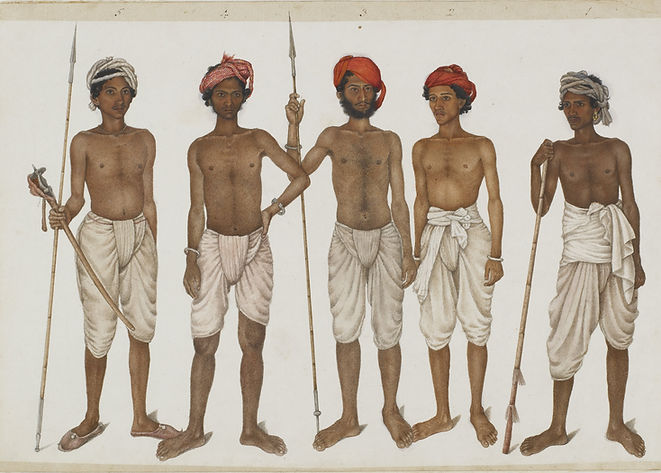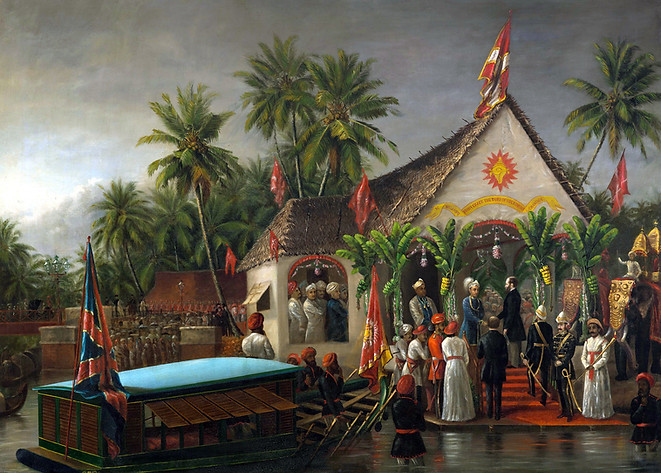

Journal
Global Nineteenth-Century Studies is a forum for scholars from a wide array of disciplines who share an interest in the world’s connectedness between 1750 and 1914. It publishes pioneering essays of transnational, comparative, transimperial, transpacific, and transatlantic significance while also serving as a venue to debate these terms and their corresponding methodologies and epistemologies. Investigating material culture forms, visual and literary texts, ideas, and sentient beings that transcend national boundaries, essays in the journal are asked to engage critically with mobility and migration, imperialism and colonialism, and production and distribution, as well as travel, technologies, and varieties of exchange. The journal welcomes submissions that explore developments within and among imperial entities, regions, and nations.
Global Nineteenth-Century Studies is published twice a year by Liverpool University Press, the United Kingdom's third oldest university press, with a distinguished history of publishing exceptional research since 1899.
Editorial Structure
Editorial Staff
Editor
Kevin A. Morrison, Henan University
Associate Editors
Parama Roy, University of California, Davis
Geoffrey A.C. Ginn, University of Queensland
Jennifer McDonell, University of New England
Maggie Cao, University of North Carolina, Chapel Hill
Section Editors
Creative Histories: Trevor R. Getz, San Francisco State University
Global Documents: Joshua Ehrlich, University of Macau, and Agnes Gehbald, University of Bern
History from Beyond: Kyle Jackson, Kwantlen Polytechnic University
Identities: Márcia Gonçalves, Leiden University
Shapes of Money: Alessandro De Cola, University of Bologna
Visions of the Global, Imperial Imaginaries, and International Public Opinion: Laura Díaz Esteve, Universidad Autonóma de Madrid, and Rodrigo Escribano, Consejo Superior de Investigaciones Científicas (CSIC); Universidad Adolfo Ibáñez
Book review editors
History: Osama Siddiqui, Providence College
Literary Studies: Jennifer Hargrave, Baylor University, and Tom Ue, Cape Breton University
Art History: Niharika Dinkar, Boise State University
Editorial Board
Laura Rosanne Adderley, Tulane University
Robert Aguirre, University of Windsor
Sascha Auerbach, University of Nottingham
Constance Bantman, University of Surrey
Manuel Barcia, University of Leeds
Fabrice Bensimon, Sorbonne Université
Chris Bongie, Queen’s University
Jennifer DeVere Brody, Stanford University
Anja Bunzel, Institute of Art History, Czech Academy of Sciences
Antoinette Burton, University of Illinois
Ross Forman, University of Warwick
Gretchen Holbrook Gerzina, University of Massachusetts Amherst
Amitav Ghosh, Novelist and essayist
Philip Howell, Cambridge University
Evelyn Hu-Dehart, Brown University
Sabrina Joseph, American University in Dubai
Hyoungee Kong, NYU Shanghai
Julia Kuehn, University of Groningen
Selina Lai-Henderson, Duke Kunshan University
Josephine Hoegaerts, University of Amsterdam
Charne Lavery, University of Pretoria
Priya Maholay-Jaradi, National University of Singapore
Sharon Marcus, Columbia University
Upamanyu Pablo Mukherjee, University of Warwick
K. Adele Okoli, University of Central Arkasas
Ian Phimister, University of the Free State
John Plunkett, University of Exeter
Jason Rudy, University of Maryland
Berny Sèbe, University of Birmingham
Susan Sidlauskas, Rutgers University
Miles Taylor, Humboldt-Universität zu Berlin
Marion Thain, Edinbugh University
Sandra Guardini Vasconcelos, University of São Paulo
David Walker, University of California, Santa Barbara
Paul Watt, University of Adelaide
Tan Tai Yong, Singapore University of Social Sciences
Natalie Zacek, University of Manchester
Sections
In addition to full-length research articles that follow the refereeing process outlined above, the journal also welcomes submissions of varying length to any of its standing sections:
Creative Histories
In the nineteenth century, as today, people communicated ideas through a vast range of media. This was the era of cartoonists like Emmanuel Poiré, picture journals like Punch and Eshimbun Nihonchi, the invention of the phonograph, and a flowering of puppet and lantern theater around the world. Many of these media conveyed messages and stories from the past, from Gustave Doré’s The Picturesque, Dramatic, and Caricatural History of Holy Russia, arguably the world’s first graphic history, to wayang histories of Hamza ibn Abdul-Muttalib and other Muslim figures, to ground-breaking data visualizations by W. E. B. DuBois, Florence Nightingale, and Charles Joseph Minard. Similarly, Global Nineteenth-Century Studies will periodically feature the unusual and alternate ways in which contemporary scholars depicted and interpreted the nineteenth century: descriptive maps, comics, data and architectural visualizations, experimental histories, and speculative biographies that mirror the richness of the nineteenth-century world. Reflective essays that engage with issues in the creative rendering of history are also welcome.
Global Documents
Joshua Ehrlich
University of Macau
and
Agnes Gehbald
University of Bern
Submissions for this section should present and analyze unpublished (or not widely available) textual or visual materials that explore the world’s connectedness in the long nineteenth century. Global documents are primary sources such as private writings, author drafts, official or technical reports or the like, that capture convergences or entanglements among or across diverse world regions. We invite contributions that draw out the significance of unpublished materials found in archives, libraries, and private collections; or that explore printed texts and images with limited circulation, or about whose reception or use little is known. This section seeks to uncover the global narratives embedded in individual texts and images. If not in English, documents should be translated, but original versions may be included when appropriate. Other formats such as roundtable discussions of one or more documents will be considered. For all proposals, the word count should be at least 2,000 words and should not exceed 9,000 words (including footnotes).
Identities
Identity has been a salient scholarly term across the humanities and social sciences since the mid-twentieth century. It can be understood as either an individual or collective phenomenon, as something that either persists through change or is unstable, as the result of self-identification processes or as something attributed by others. These ambiguities of meaning have inspired diverse and even contradictory theoretical approaches, leading to reflections on whether ‘identity’ is useful as an analytical concept. The categories of analysis developed by contemporary scholars, however, often differ from those that people in the past created and relied on to explain and organise their social practices. This section welcomes submissions that lay bare the contingent and possibly contradictory processes by which historical actors produced, organised, used, and contested identities and processes of identification in any particular setting — within and among imperial formations, regions, or nations — in the long nineteenth century.
History from Beyond
Historians who study the nineteenth-century world are heir to a set of conceptual tools forged by intellectuals in a small part of that world. While euromethodologies have proven illuminating, much historical evidence has been cast aside without good reason, while the lived experience, truths, and knowledges of diverse peoples have been downgraded as “belief.” What alternative ways of doing history have been relegated to the shadows by our discipline’s post-Enlightenment assumptions? Global Nineteenth-Century Studies will periodically feature “History from Beyond”—interventions that seek to open up new questions or approaches beyond disciplinary norms, beyond humans, and beyond euromethodologies. We especially welcome submissions that seek to challenge the core assumptions of Western modernity, close the gap between Western constructions of the past and wider-world realities, decolonize and Indigenize historical storytelling, or more seamlessly integrate non-Western epistemologies, the unknown, or the mysterious into historical narrative.
Visions of the Global, Imperial Imaginaries, and International Public Opinion
Laura Díaz Esteve, Universidad Autonóma de Madrid
and
Rodrigo Escribano, Consejo Superior de Investigaciones Científicas (CSIC); Universidad Adolfo Ibáñez
The global dialogues, conflicts and collaborations that characterized the long nineteenth century were not resolved by diplomatic, military or economic power alone. Flows of knowledge and information were nurtured and reformulated as they circulated from and through different empires and colonies, carrying with them ever-changing imaginaries of their different societies, worldviews and circumstances. These complex conceptions of other communities profoundly conditioned the decisions of actors at different levels. The media, with the periodical press as the main protagonist, played an essential and influential role in their construction. This section invites articles, roundtables and discussion papers that explore the media that disseminated these global visions and their profound impact on the configuration of the nineteenth-century world.
Shapes of Money
Money and financial institutions were among the most powerful drivers of global integration during the long nineteenth century. As Benjamin J. Cohen argues, while the Westphalian model of the nation-state emerged in seventeenth-century Europe, the myth of One Nation/One Money—embodied in the territorialization of national currencies—materialized in the nineteenth century. Yet, alongside the consolidation of national currencies, “international money” continued to circulate across political and geographical boundaries, and new transnational monetary unions emerged.
The growing prominence of central banks in the “West” paralleled the rise of the idea of an International Monetary System. However, the European model of financial integration was just one facet of a much broader global financial landscape. The nineteenth-century transportation and communication revolution facilitated unprecedented flows of capital across borders, sustained by the activities of bankers, traders, shroffs, qianzhuang, and other intermediaries. While the quest for financial stability led parts of the world to adopt gold as a standard of value, the silver economy remained dominant in regions such as the Indian Ocean. Simultaneously, regional and local exchange systems, often characterized by the complementary circulation of diverse means of exchange, sustained vibrant local markets despite efforts by political authorities to impose uniform currency areas.
This section of Global Nineteenth-Century Studies seeks to explore the dynamics of adaptation and hybridization within the global financial system, with a focus on the material diversity of financial instruments. We invite long or short essays (minimum 5,000 words) that center on the visual and material analysis of financial objects, including coins, banknotes, bills of exchange, and postal orders, as well as other widely employed mediums of exchange such as shells, salt bars, manillas, and cloth.
By engaging with the materiality of these objects, this section aims to transcend their financial functions and illuminate the sociocultural roles and meanings embedded within them.

_Holding_Two_Carriage_Hors.jpeg)


